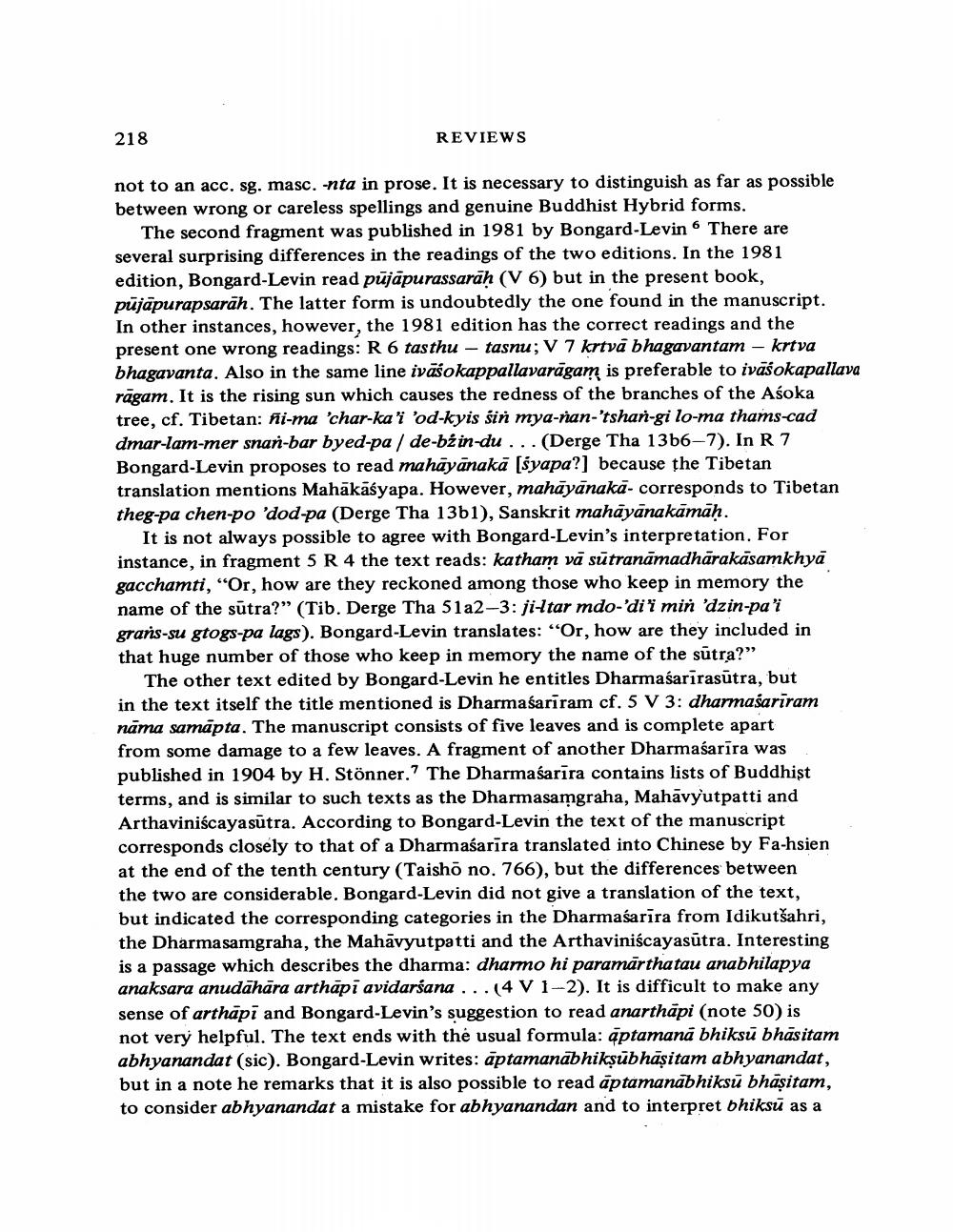________________
218
REVIEWS
not to an acc. sg. masc. -nta in prose. It is necessary to distinguish as far as possible between wrong or careless spellings and genuine Buddhist Hybrid forms.
The second fragment was published in 1981 by Bongard-Levin 6 There are several surprising differences in the readings of the two editions. In the 1981 edition, Bongard-Levin read pūjāpurassarah (V 6) but in the present book, pūjāpurapsarāh. The latter form is undoubtedly the one found in the manuscript. In other instances, however, the 1981 edition has the correct readings and the present one wrong readings: R 6 tasthu – tasnu; V 7 krtvá bhagavantam - krtva bhagavanta. Also in the same line ivāśokappallavarāgam is preferable to ivāśokapallava rāgam. It is the rising sun which causes the redness of the branches of the Aśoka tree, cf. Tibetan: hi-ma 'char-ka'i 'od-kyis ŝin mya-ran-'tshan-gi lo-ma thams-cad dmar-lam-mer snan-bar byed-pa / de-bź in-du ... (Derge Tha 13b6-7). In R7 Bongard-Levin proposes to read mahāyānaka (śyapa?] because the Tibetan translation mentions Mahākāśyapa. However, mahāyānaka- corresponds to Tibetan theg-pa chen-po 'dod-pa (Derge Tha 13b1), Sanskrit mahāyānakāmāḥ.
It is not always possible to agree with Bongard-Levin's interpretation. For instance, in fragment 5 R 4 the text reads: katham vā sūtranāmadhārakasamkhyā gacchamti, "Or, how are they reckoned among those who keep in memory the name of the sūtra?” (Tib. Derge Tha 51a2-3: ji-tar mdo-'di i min 'dzin-pa'i grars-su gtogs-pa lags). Bongard-Levin translates: "Or, how are they included in that huge number of those who keep in memory the name of the sūtra?”
The other text edited by Bongard-Levin he entitles Dharmasarirasutra, but in the text itself the title mentioned is Dharmaśariram cf. 5 V 3: dharmasariram nāma samāpta. The manuscript consists of five leaves and is complete apart from some damage to a few leaves. A fragment of another Dharmaśarīra was published in 1904 by H. Stönner. The Dharmaśarīra contains lists of Buddhist terms, and is similar to such texts as the Dharmasamgraha, Mahāvy'utpatti and Arthaviniscayasūtra. According to Bongard-Levin the text of the manuscript corresponds closely to that of a Dharmaśarīra translated into Chinese by Fa-hsien at the end of the tenth century (Taisho no. 766), but the differences between the two are considerable. Bongard-Levin did not give a translation of the text, but indicated the corresponding categories in the Dharmaśarira from Idikutšahri, the Dharmasamgraha, the Mahāvyutpatti and the Arthaviniscayasūtra. Interesting is a passage which describes the dharma: dharmo hi paramarthatau anabhilapya anaksara anudāhāra arthāpi avidarśana ...(4V 1-2). It is difficult to make any sense of arthāpi and Bongard-Levin's suggestion to read anarthāpi (note 50) is not very helpful. The text ends with the usual formula: aptamana bhiksū bhāsitam abhyanandat (sic). Bongard-Levin writes: aptamanabhikṣūbhāṣitam abhyanandat, but in a note he remarks that it is also possible to read aptamanabhiksū bhāṣitam, to consider abhyanandat a mistake for abhyanandan and to interpret bhiksū as a




